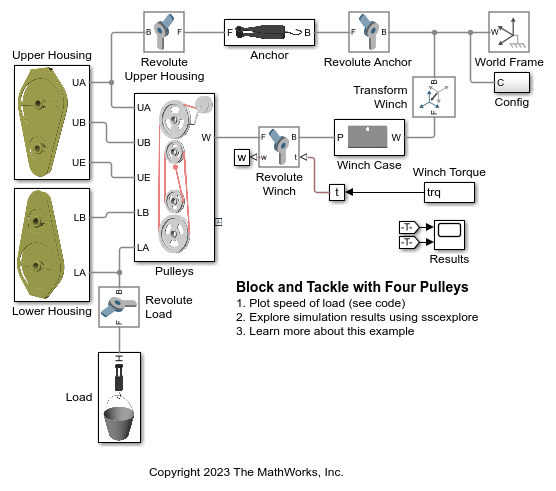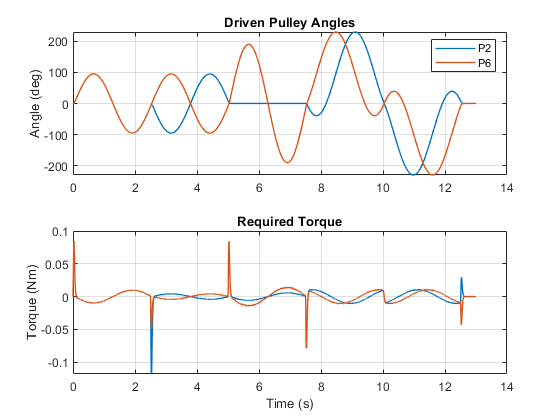Pulley
Wheel wrapped in a cord for the transmission of torque and motion
Libraries:
Simscape /
Multibody /
Belts and Cables
Description
The Pulley block represents a grooved or toothed wheel wrapped in a cord, an arrangement used frequently in the transmission of torque and motion in part for the mechanical advantage that it can provide. The pulley (or sprocket if toothed) is ideal: massless and frictionless, with zero slip permitted between its surface and the surrounding cord, itself idealized as taut and inextensible. Use the pulley singly or as part of a compound pulley system such as the block and tackle of a hoist or the timing belt of a car engine.
The pulley has one local reference frame (frame port R) and two cord tangency points (belt-cable ports A and B). The reference frame is placed with its origin at the center of the pulley and its z-axis along the rotation axis of the same. The cord tangency points coincide with the locations at which the cord meets or separates from the pulley. These locations can change during simulation. The belt or cable wraps around the pulley from port A to port B so as to trace a counterclockwise arc about the z-axis.

In a closed-loop system of two pulleys—such as a belt drive—the connections of the belt-cable ports determine whether the cord geometry is crossed or open. As shown in the following schematic, in a system of pulleys in which the z-axes are aligned in parallel, if port A of one connects to port A of another, then the cord is crossed; if port A of one connects to port B of another, then the cord is open. The effect is the same if instead of switching the port connections, one of the frames is flipped so that the z-axes of the pulleys are anti-parallel.

The degrees of freedom of the pulley depend entirely on the joints and constraints (if any) to which it connects. Attaching a pulley to a case by means of a revolute joint imparts to the pulley one rotational degree of freedom relative to the case; one is then free to rotate relative to the other. Fixing the pulley to another pulley, by means of a direct connection, a rigid transform, or a weld joint, constrains the two so that if one rotates, then so must the other.
By default, the cord can enter and exit a pulley at an angle to its center plane (θ in the figure). This angle can vary during simulation—for example, due to translation of the pulley on a prismatic joint. While the contact point is always in the center plane of the pulley, the pulley can move when mounted on a joint. The cord can also be constrained to enter and exit the pulley in its center plane. Whether this constraint is enforced depends on the settings of the Belt-Cable Properties block.

The pulleys must remain at distances that preserve the natural length of the cord. This length is computed from the initial placements of the pulleys and it is fixed: the cord can neither stretch nor slacken during simulation. The length calculations include the arc lengths of the cord about the pulleys. The contact between them is idealized as slipless, with a contact point on the cord always moving at the same instantaneous velocity as its counterpart on the pulley.
Note that the frame and belt-cable ports belong to different multibody domains. As a rule, ports connect only to like ports—frame ports to other frame ports, belt-cable ports to other belt-cable ports. The belt-cable domain has the special requirement that each network or belt-cable connection lines connect to one (and no more than one) Belt-Cable Properties block. It is through that block that the visualization of the cord is configured and the length of the same is (on diagram update) computed.
The visualization of the cord is in the form of a pitch line. The cord meets and separates from the pulley tangent to its circumference. The arc of contact between the cord and the pulley is called the pitch arc. The pitch line of the cord is the sum of the line segments between different pulleys and of their respective pitch arcs. The line segments between the pulleys are shown as rectilinear, consistent with the constraint that no slackening is allowed to take place.
Combine the Pulley block with the Belt-Cable Spool block to retrieve from a winch, and to return to it, additional lengths of cord. An example application is the lowering and raising of the hook block of a tower crane. Use the Belt-Cable End block to define an end point to the cord. The end point contains a frame for connection to a load, fixture, or other part of a multibody model.
Examples
Ports
Frame
Belt-Cable
Parameters
Extended Capabilities
Version History
Introduced in R2018a










